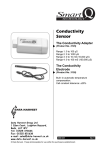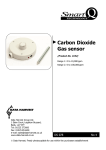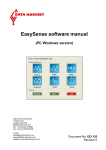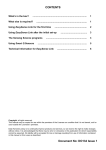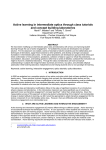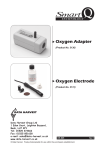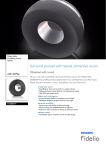Download Enter o to this page the details for the document
Transcript
Chemistry Sensors: Loggers: pH Any EASYSENSE Logging time: Meters Teacher’s notes 16 Measuring pH values of everyday substances Read This practical is an extension of the “measuring pH” activity; it uses everyday materials to explore pH rather than “mysterious chemicals” out of laboratory glassware. If it can be arranged, the solutions to be tested should be contained in their “commercial” packages to reinforce the everyday nature of the solutions being tested. There are many misconceptions about pH and “strength” of the acid / alkali. This activity does provide an opportunity to consider why sulphuric acid pH 1.0 is considered dangerous and needs safety goggles yet cola is also pH 1.0 and we can drink it and not have to consider safety gear. You could also consider ‘is that well known soap really neutral pH?’ - even when it is in a water solution. Apparatus 1. An EASYSENSE logger. 2. A Smart Q pH sensor. 3. 6 solutions in beakers labelled with contents, all at the same temperature (for accuracy). • A = Carbonated drink(s) e.g. Cola. • B = Soap solution. • C = Vinegar. • D = Salt solution. • E = Lemon juice. • F = Sodium bicarbonate solution (NaHCO3) - Sodium hydrogen carbonate. 4. Wash bottle of distilled water. 5. Large beaker for waste. Set up of the software and logger. Use Meters or SnapShot. Both are found from the Home screen of the EasySense software and require no setup. If the logger has an LCD screen readings can be taken directly from the screen and the software does not have to be used. SnapShot is useful if you want the students to keep a permanent computer based record, otherwise use Meters in preference. L3 Chemistry T16 - 1(V2) Notes Refer to the user manual for the pH sensor for care instructions. They will produce good results until the central electrolyte is almost exhausted. The skirt must be used to protect the fragile glass bulb at the electrode end. Use small 50 or 100 ml beakers to test the solutions, there is no advantage in using a larger beaker. Make sure that if large glassware is being used the quantity of test solution is enough to cover the electrode tip when testing. Watch out for confusion between volume / quantity and strength, it is not uncommon to hear students suggest it is stronger because there is more. Concentration can be a difficult concept for many. It can be useful to have pH test papers present to reinforce the Universal Colour code for pH, some students may doubt the sensor if the pH of water is not 7.0, a back up test is often useful to help sway the doubters. If you are using Meters select a Changes section, the colour change is a match to the universal colour code. As with all digital instruments, a user can become obsessed with the residual decimals that are shown. Try to encourage the students to, initially, use “X.0” and “X.5” and round up and down between; this is still more accurate than they would get with test papers. pH does change with temperature, results from different groups can vary, temperature of the test solutions can be a reason. Other reasons for variation can be that sensors may have slightly different characteristics due to contamination of electrode glass or “salt bridge” of the electrode or the solutions are genuinely changing pH by cross contamination. L3 Chemistry T16 - 2(V2)


